Cards In This Set
| Front | Back |
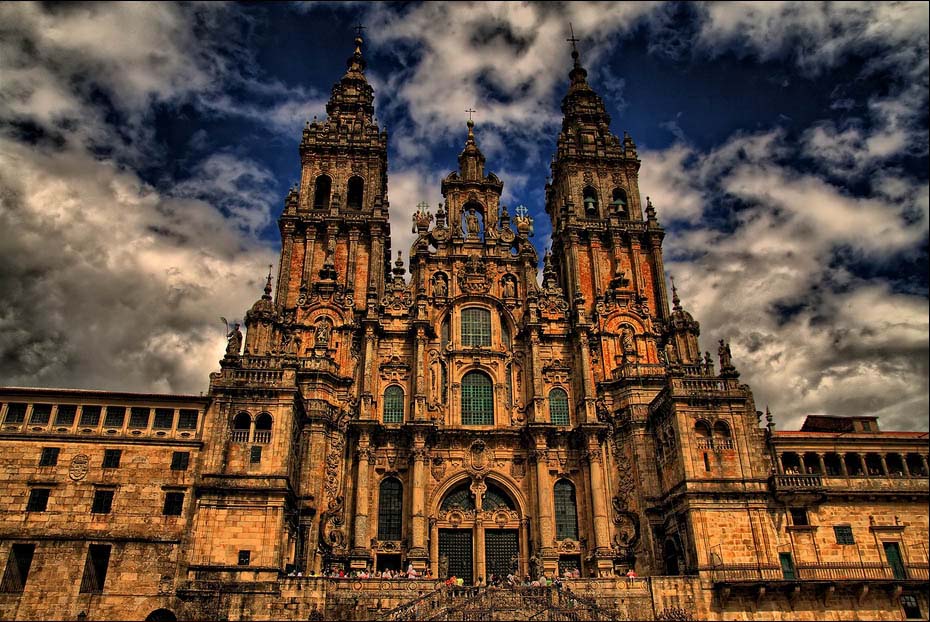 Cathdreal of santiago de compostela Romaesque art Spain 1075-1120 |
 People go on pilgramage to view it. Wanted to show the suffering of chirst. reminded artichest of much early rome architeter. sophisicated valuting barrel groin valuting. allmason reconstructoin the nave of the church the floor plan is a spanish cross. prinicpal nave has a barrel vault incredibely long gated columnsThe basilica has a pilgrimage of a Latin cross. The main hall, preceded by a nártex and flanked by aisles, leads to an open four transept chapels. The main hall is covered by a barrel vault of Roman origin, while the aisles by vaults edges, originating from the Roman period. The gallery, located on the top floor of the ambulatory have barrel vaults quarter. The choir has an ambulatory five radial chapels. The header consists of a chapel axial semicircular plan within it. The building receives indirect lighting through the windows of the aisles. The ensemble is completed by two towers on the facade and a tower at the junction between the nave and transept. The nave has a height of 22 m, while the interior arches rise to only 9.50 m. |
 Prohphet Trumeau South Portal St.Pierre, Moissac, France Early 12th C Romanesque Art |
 Figuritive Figure comes from roman releif scultures and manuscript elongated figure shows mystical expression the face. figure seems to float lions serves as guardian of the church Jeremiah (on one side) and Isaiah (on the other) point literaly and symbolically to the vision. elongated and expressionistic body. Tympanum and jamb figures meant for pilgrims to see and envoke a vision of a earthly Jerusalem. or a heaven on earth. It could also have induce fear or hope of the second coming of christ. |
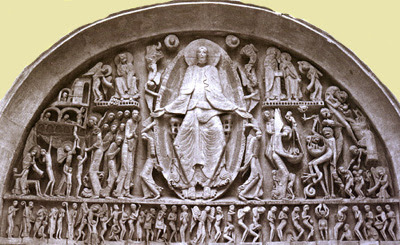 Giselbertus -artist Last Judgement Westy Tympanum Catherdral Saint-Lazare France 1120-35 Romanesque |
 Enthroped christ in center figures emerging from graves belwo angel weighing the soles for good or bad this a reminder of the importance of the judgement |
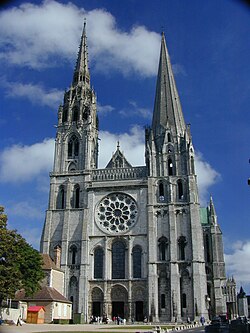 Chartes Catherdral Cathedral of Notre Dame France Mid 12th Gothic Art |
 Towers on the western facade spiders at the top of the tower. towers are reaching up to the heaven vertically use of the pointed arch allowed for stability and arch to go higher rib vault narrow tall space inside 118 feet high stained glass with jewels on clerestory skellatol constuction elaborate relief scultpre and gargoyles in relif The high nave is supported by double flying buttresses, anchored by colonnettes and great abutments. The latter were lightened in appearance with niches filled with sculptures. An extra row of single flying buttresses supported the apse from the beginning and a third row was added in the 14th century. |
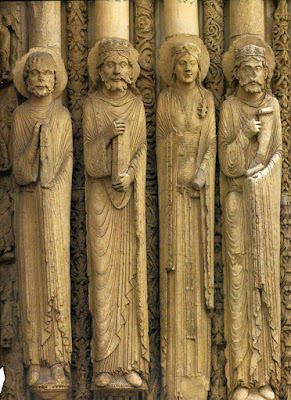 West Royal Portal Chartres Catherdral Jamb Statues France Mid 12thc Gothic Art |
 Focuses on the coming of christ was part of a campaign to beautify the cathedral, which began in the time of Bishop Ivo |
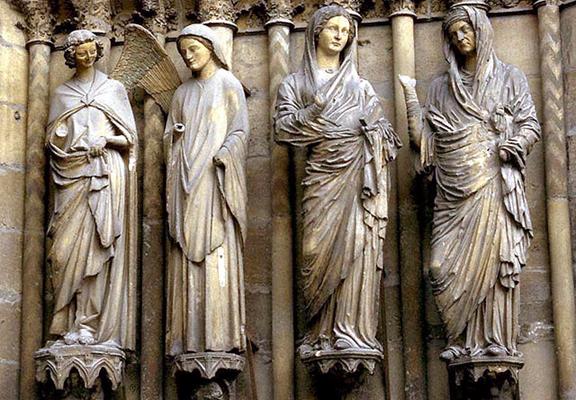 Annuction and Visitation Jamb Statues West Portal Notre Dame Cathedral France 13th C Gothic ARt |
 Different sculptors working in diverse styles carved the Reims jamb statues, but all detached their figures from the columns and set the bodies and arms in motion. The figures converse through gesture and display both Greek origins in their bodies and clothes, and also the French maneurisms. |
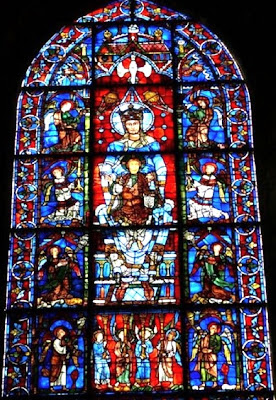 Notre Dame de la Belle Verriere Chartes Catherdral France 12th C Gothic art |
 The three upper-central panels (14, 17 and 20), representing the Virgin carrying the Christ Child on her lap in a strongly frontal pose (the so-called Sedes Sapientiae or 'Throne of Wisdom' format) are mid-12th century in date - rare survivors from Fulbert's glazing programme, possibly from the eastern axial chapel. They survived the fire of 1194 and were later re-fitted in this window, which otherwise dates from c.1220. The 13th century saw many such examples of earlier panels being re-used, as if their supposed antiquity (in fact most were little more than a generation or two old) gave them a special sanctity. From the 15th century onwards such recycled panels became known as Belles verrieres - many such exist though this is perhaps the most famous. As with the west windows, although the roots of the Virgin and Child panels are 12th century, they have been so heavily restored, in the 13th, 14th and 19th centuries, that relatively little of the original glass survives (for example, of the Virgin's halo, only two small fragments are original). |
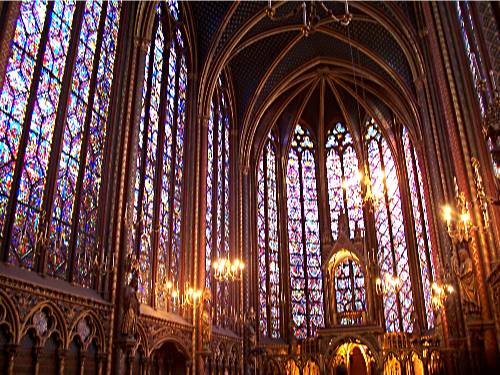 Sainte Chapelle Paris 13th Gothic art |
 Despite some damage the windows display a clear iconographical programme. The three windows of the eastern apse illustrate the New Testament, featuring scenes of The Passion (centre) with the Infancy of Christ (left) and the Life of John the Evangelist (right). By contrast, the windows of the nave are dominated by Old Testament exemplars of ideal kingship/queenship in an obvious nod to their royal patrons. The cycle starts at the western bay of the north wall with scenes from the Book of Genesis (heavily restored). The next ten windows of the nave follow clockwise with scenes from Exodus, Joseph, Numbers/Leviticus, Joshua/Deuteronomy, Judges, (moving to the south wall) Jeremiah/Tobias, Judith/Job, Esther, David and the Book of Kings. The final window, occupying the westernmost bay of the south wall brings this narrative of sacral kingship right up to date with a series of scenes showing the rediscovery of Christ's relics, the miracles they performed, and their relocation to Paris in the hands of King Louis himself |
|
Ambultaroy
|
A place for walking, esp. an aisle around the apse or a cloister in a church or monastery.
|
|
Transepts
|
(in a cross-shaped church) Either of the two parts forming the arms of the cross shape, projecting at right angles from the nave.
|
|
Rib Vault
|
Six or more vaults
|
|
Piers
|
Is an upright support for a structure or superstructure, such as an arch or bridge.
|
|
Skeletal construction
|
a method of construction in which the walls are supported at ground level by a steel frame consisting of vertical and horizontal members.. |
|
Buttress
|
A projecting support of stone or brick built against a wall. |
|
Tympanum
|
The area enclosed by apediment, whether triangular or segmental.
|



